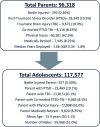Impact of parental injury on adolescent sleep
- PMID: 32336323
- PMCID: PMC7970591
- DOI: 10.5664/jcsm.8514
Impact of parental injury on adolescent sleep
Abstract
Study objectives: The aim of this study was to determine the impact of serious parental injury on adolescent sleep disorder diagnoses, outpatient care, and medication use.
Methods: U.S. military personnel who sustained a serious injury and were parents of adolescents aged 10-18 years were identified. Included adolescents were enrolled in the Military Health System for 2 years before their parent's injury and 2 years after the injury. We used logistic regression clustered by adolescents to compare the odds of having a sleep diagnosis and negative binomial regression analysis clustered by adolescents to compare outpatient sleep disorder visits and sleep medication days before and after parental injury.
Results: There were 96,318 parents seriously injured during 2004-2014 who had 117,577 children aged 10-18 years in 2002-2016. Approximately 2% of adolescents had a sleep disorder diagnosis, both before and after their parent's injury or illness. Outpatient sleep disorder visits increased 36% after a parent's injury (incidence rate ratio 1.36 [1.24-1.50]), with a twofold increase in insomnia visits (incidence rate ratio 2.35 [2.08-2.64]). Increases in sleep visits were most pronounced in adolescents of parents with traumatic brain injury, comorbid traumatic brain injury and posttraumatic stress disorder, battle injury, and those who were medically discharged from the military. The number of adolescents using sleep medications increased, but sleep medication days did not increase.
Conclusions: Adolescents in our study used more outpatient medical care for sleep disorders; sleep medication use increased after parental injury. Sleep disorders should be considered in the care of adolescents with injured parents.
Keywords: adolescent; brain injuries; family health; military family; parents; posttraumatic stress disorders; sleep; wounds and injuries.
© 2020 American Academy of Sleep Medicine.
Figures
Similar articles
-
The Impact of Parental Injury on Children's Mental Health Diagnoses and Classes of Psychotropic Medication by Child Age.Mil Med. 2021 Jan 25;186(Suppl 1):222-229. doi: 10.1093/milmed/usaa466. Mil Med. 2021. PMID: 33499532
-
The Impact Of Military Parents' Injuries On The Health And Well-Being Of Their Children.Health Aff (Millwood). 2019 Aug;38(8):1358-1365. doi: 10.1377/hlthaff.2019.00276. Health Aff (Millwood). 2019. PMID: 31381386
-
Chapter 8 Military Personnel With Traumatic Brain Injuries and Insomnia Have Reductions in PTSD and Improved Perceived Health Following Sleep Restoration: A Relationship Moderated by Inflammation.Annu Rev Nurs Res. 2015;33:249-66. doi: 10.1891/0739-6686.33.249. Annu Rev Nurs Res. 2015. PMID: 25946388
-
Posttraumatic Stress Disorder, Traumatic Brain Injury, Sleep, and Performance in Military Personnel.Sleep Med Clin. 2020 Mar;15(1):87-100. doi: 10.1016/j.jsmc.2019.11.004. Epub 2020 Jan 8. Sleep Med Clin. 2020. PMID: 32005353 Review.
-
Insomnia in the Military: Application and Effectiveness of Cognitive and Pharmacologic Therapies.Curr Psychiatry Rep. 2015 Oct;17(10):85. doi: 10.1007/s11920-015-0622-9. Curr Psychiatry Rep. 2015. PMID: 26364060 Review.
Cited by
-
July 14th 2016 Nice Terrorist Attack Court Trial: A Protocol on Sleep Quality and Somatic Symptoms as Markers of Risk for Traumatic Reactivation in Adolescents Exposed to This Attack.Healthcare (Basel). 2023 Nov 12;11(22):2953. doi: 10.3390/healthcare11222953. Healthcare (Basel). 2023. PMID: 37998445 Free PMC article.
-
Nightmares and Sleep Disturbances in Children with PTSD: A Polysomnographic and Actigraphy Approach Evaluation.J Clin Med. 2023 Oct 17;12(20):6570. doi: 10.3390/jcm12206570. J Clin Med. 2023. PMID: 37892709 Free PMC article.
References
-
- National Sleep Foundation . Adolescent Sleep Needs and Patterns: Research Report and Resource Guide. Arlington, VA: National Sleep Foundation; 2000.
MeSH terms
LinkOut - more resources
Full Text Sources
Medical


